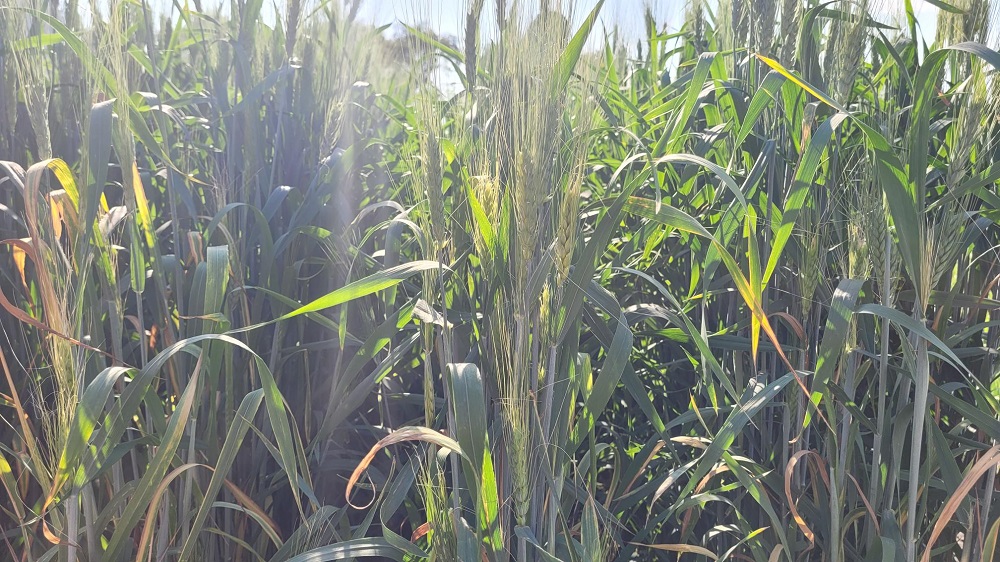Minimal rain was received this week with five mm of rain being the most recorded in the Avonlea area while other areas of the southeast received only trace amounts. The warm and dry conditions persisted this past week and soil moisture continues to be limited. Currently, 12 per cent of cropland has adequate moisture, 48 per cent short and 40 per cent very short. Hay and pasture land soil moisture is even more limited, with seven per cent rated as adequate, 32 per cent short and 61 per cent very short. Producers are hoping for rain this fall and snow this winter to help with topsoil moisture next spring.
Pastures in the region are seeing the effects of limited moisture. Twenty-one per cent are in fair condition, 58 per cent are poor and 16 per cent are very poor.
Crop damage this week was due to drought, high temperatures and grasshoppers. Producers are busy finishing their haying and silage operations, preparing combines and getting ready for harvest.
Some parts of the region received much needed moisture this week, while others received only trace amounts. Rockglen received the most with 28 mm being reported. Cropland topsoil moisture is limited in the region. Cropland is currently 10 per cent adequate, 36 per cent is short and 54 per cent is very short. Hay and pasture land is very similar, where 12 per cent has adequate moisture, 32 per cent is short and 56 per cent is very short.
Pastures in the southwest have had little opportunity to rejuvenate during the hot and dry summer. Four per cent of pastures are in good condition, 19 per cent are in fair condition, 31 per cent are poor and 46 per cent are very poor. Some producers are planning to use failed grain crops for feed this year
Crop damage is week is due to drought and grasshoppers. Producers are busy assessing potential yields and feed supply for this winter. Many are out harvesting or baling failed crops.
Minimal rain was received this week. The Lumsden area reported the most rain with just six mm, the rest of the region received only trace amounts of precipitation, if any. Topsoil moisture further declined this week; seven per cent of cropland has adequate topsoil moisture, 57 per cent is short and 36 per cent is very short. Hay and pasture land follow a similar pattern where eight per cent has adequate moisture, 48 per cent is short and 44 per cent is very short. Producers are hoping for additional moisture to help with next year’s crop.
A lack of rain throughout the growing season meant pasture conditions declined. Two per cent of pastures are in good condition, 30 per cent are fair, 48 per cent are poor and 20 per cent are very poor.
Crop damage this week was due to drought and grasshopper pressure. Producers are busy preparing for harvest, assessing crop yields and feed supplies and finishing haying and silage operations.
Some parts of the west-central region have received significant moisture; Smiley received 43 mm of rain this week while other parts of the region received as little as trace amounts. The topsoil moisture in the region continues to be limiting. Ten per cent of cropland has adequate topsoil moisture, 49 per cent is short and 41 per cent is very short. Hay and pasture land topsoil moisture is more limited; four per cent has adequate moisture, 41 per cent is short and 55 per cent is very short. Rain is needed to replenish the soil for next year’s crop.
With the limited rain this summer, pasture conditions are less than ideal. Two per cent of pastures are in good condition, while 28 per cent are fair, 35 per cent are poor and 35 per cent are very poor.
Crop damage this past week was due to drought and grasshoppers. Producers are busy assessing crop yield and feed supply for this winter, preparing for harvest and desiccating pulse crops.
Parts of the region received some significant moisture this past week with Prince Albert receiving 53 mm of rain. This rain helped replenish soil moisture levels. Currently, 31 per cent of cropland in the northeast has adequate topsoil moisture, 54 per cent is short and 15 per cent is very short. Hay and pasture land is slightly more limited for moisture, 14 per cent has adequate moisture, 69 per cent is short and 17 per cent is very short.
Pastures in the northeast are generally in fair condition. Currently, six per cent are in good condition, 58 per cent are fair, 34 per cent are poor and two per cent are very poor.
Crop damage this past week is due to heat, some reports of hail and insect pressures. Producers are busy finishing haying and silaging, preparing machinery and bins for harvest, desiccating pulse crops and evaluating potential yields and feed supplies for this winter.
The region had some significant moisture this past week with 47 mm was received in the Shellbrook area. Other areas received as little as trace amounts. The warm and dry conditions persisted despite the rain and caused a decrease in topsoil moisture. Twenty-four per cent of cropland has adequate topsoil moisture, 60 per cent is short and 16 per cent is very short. Similarly, 21 per cent of hay and pasture land has adequate moisture, 57 per cent is short and 22 per cent is very short.
Pastures in the northwest are generally in poor condition. Eleven per cent of pastures are in good condition, 34 per cent are fair, 46 per cent are poor and nine per cent are in very poor condition. Producers are finishing their haying operations and are beginning to cut green feed.
Crop damage this past week is due to dry conditions and insect damage from lygus bugs and grasshoppers. Producers are busy with haying, desiccating and preparing machinery and bins for harvest.








